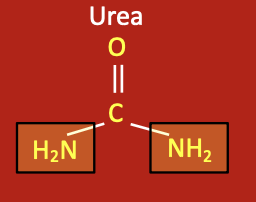UCM Animal Nutrition Quiz 2
1/69
There's no tags or description
Looks like no tags are added yet.
Name | Mastery | Learn | Test | Matching | Spaced |
|---|
No study sessions yet.
70 Terms
why do microbes like the rumen?
because it is warm, moist, and low in oxygen which allows anaerobic microbial digestion to occur (anaerobic = little or no oxygen)
what three volatile fatty acids are produced during microbial digestion?
acetate
propionate
butyrate
how does the ruminant animal get protein is the microbes consume protein to create volatile fatty acids?
after some time in the rumen, the microbes make their way through the digestive system with the digest and are killed in the abomasum.
they are then digested in the duodenum and the amino acids from the digested protein from the microbes is absorbed in the jejunum and the ileum to provide the protein for the ruminant.
how/where are the volatile fatty acids absorbed?
through the papillae in the rumen wall
reticulum job
main function: regurgitate partially digested feed back to the mouth for rumination
also helps to catch foreign objects in feed to protect the digestive tract
omasum job
not understood completely, mainly responsible for moving digesta into the abomasum, absorbing excess fluid from the rumen, absorbing VFAs and grinding of the digest from the rumen
abomasum job
TRUE STOMACH OF THE RUMINANT (all three types of digestion occur; mechanical, chemical, and enzymatic)
mixes the feed bolus with hydrochloric acid (chemical) and pepsin (enzymatic) by muscular contractions (mechanical)
compare and contrast the ruminant small intestine to the monogastric small intestine
comparisons:
the pancreas and the gall bladder secrete enzymes, buffers, and bile into the duodenum
protein and lipid digestion and absorption occurs
contrasts:
is not the major site of carbohydrate digestion and absorption because the majority of carbohydrates have already been digested and absorbed as VFAs in the rumen
cecum job in ruminants
second opportunity for microbial digestion of forage, nothing compared to the microbial digestion happening in the rumen
VFAs produced here are absorbed through the cecum wall
newborn ruminant rumen
nonfunctional and nonexistent
milk flows from the mouth → esophagus → omasum → abomasum
reticular groove
important in young ruminants
prevents milk from flowing into the undeveloped rumen
forms in response to the sucking reflex
development of the rumen
rumen will begin developing over a six week period after birth
development is dependent on the consumption of solid food
as forage is consumed this allows for microbial digestion to occur which produced VFAs and causes the development of papillae
when is the rumen developed enough for weening?
1-5 month of age the rumen is developed enough to survive on forages
sheep/goats = 1 month
cattle = 3.5-5 months
rumen size percentage change during development
reticulorumen = 30% of the stomach
abomasum = 60% of the stomach
reticulorumen = 85% of the stomach
abomasum = 8% of the stomach
distribution of feedstuffs in the rumen
forages are on top of the rumen fluid (raft)
grains sinks to bottom of the rumen fluid
define hindgut fermentation
microbial digestion takes place in the cecum located between the small intestine after the feed has passed through the stomach
why are the microbes not a source of protein in hindgut fermentation?
since microbial digestion takes places after the stomach it is impossible for the microbes the be killed in the stomach (by protease related from the pancreas) and digested as proteins and absorbed in the small intestine
horse teeth
top and bottom incisors and molars
esophagus in hindgut fermenters
feed only travels down the esophagus
hindgut fermenters CANNOT vomit
this is an issue if something poisonous is eaten because the horse cannot throw up to alleviate the problem
hindgut fermenter stomach
main site of digestion bc all three forms of digestion occur (mechanical, chemical, and enzymatic)
hydrochloric acids kills most microbes but some survive and live in the cecum to perform microbial digestion
hindgut fermenter small intestine
normal three sections and functions
horses do not have a gallbladder
liver continuously releases bile instead
no gall bladder because horses do no consume a high lipid diet so the bile does not need to be stored to emulsify the lipids
hindgut fermenter cecum
SITE OF MICROBIAL DIGESTION
chyme flows in the cecum → digested by microbes → flows out the cecum the way it came in
no enzymes to buffered are secreted
VFAs are produced from microbial digestion
absorbed in the cecum and colon (large intestine)
main source of energy for the horse
horse cecum = 4ft long and hold 8 gallons
swine cecum is only 10in long and holds 0.5 gallons
colic
pained caused by the sharp turn of the horses’ large intestine which lead to compaction of feces and blockages, can lead to death if not treated
compare and contrast the microbial digestion of the hindgut fermenters and ruminants
compare:
both used forages for energy by microbial digestion
contrasts:
hindgut fermenters use microbial digestion in the cecum
ruminants use microbial digestion mainly in the rumen but also in the cecum
compare and contrast microbial digestion of the hindgut fermenter and other monogatsrics
compare:
both have a cecum
contrast:
only hindgut fermenters can utilize forages due to microbial digestion in the cecum, other monogastrics cannot do this as efficiently
chicken teeth
no teeth, beak is used to peck food and break it apart (mechanical digestion)
poultry esophagus
food enters the mouth then travels down the esophagus to the crop
crop
modification of the esophagus where food can be temporarily stored, secretions (saliva) in the crop soften the feed
proventriculus
TRUE STOMACH IN POULTRY (all three forms of digestion are present)
mechanical = muscular contraction s
chemical = hydrochloric acid
enzymatic = pepsin
gizzard
MAIN SITE OF MECHANICAL DIGESTION
purpose is to grind up the chyme from the proventriculus via muscular contractions and grit
tough tissue lining
mostly unnecessary with modern poultry bc food is already processed
poultry cecum
two ceca present
some microbial digestion but VFAs produced have little effect on energy intake
cloaca
chamber for the digestive, urinary, and reproductive passages
opens externally at the vent
digestion in the body
breaking feed particles into microscopic nutrient molecules by mechanical, chemical, and enzymatic digestion
absorption into the body
absorbing the microscopic nutrient molecules into the blood stream from the GI tract
metabolism by the body
using the microscopic nutrient molecules in the body’s cells
difference between carbohydrates and protein?
nitrogen !
carbohydrates do not contain N
proteins do contain N in the amino acid
how is protein used for structure in animal bodies
muscle
connective tissue
bones
hair/wool
how is protein used for physiological purposes in animal bodies
enzymes
blood proteins
hormones
antibodies
how are proteins used as a source of energy in animal bodies
if starving, the muscle tissue can be broken down and used for energy
what is a protein
a specific group of amino acids that can connected in a long chain (polypeptide chain)
what are amino acids
amino group
NH2 chemical group
carboxylic acid group
COOH chemical group
side chain
R, what makes each AA unique
draw an amino acid real quick go
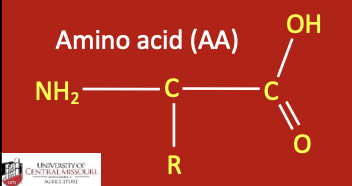
how are amino acids connected to form a protein
peptide bonds
COOH group and NH2 group release H2O, allowing the C and N to create a covalent bond (peptide bond)
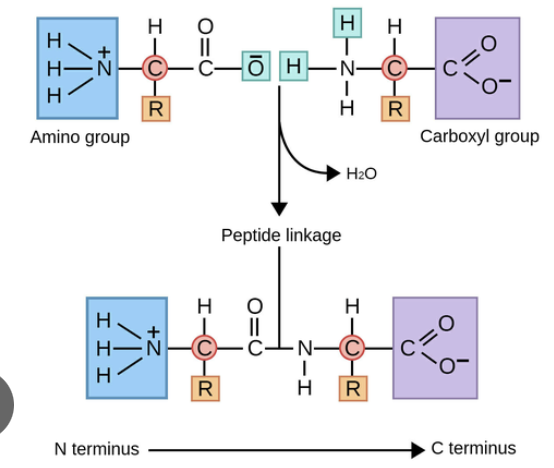
define essential amino acid
amino acids that the animal’s body cannot make on its own and must be consumed in the diet to be present in the body
what are the 10 essential amino acids
PVT TIM HALL
phenylalanine
valine
tryptophan
threonine
isoleucine
methionine
histidine
arginine
leucine
lysine
what are limiting amino acids
essential amino acids that are present in the lowest amount in the diet
most common in animal livestock = lysine, methionine, threonine
draw lysine
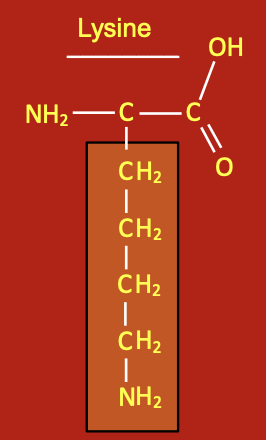
draw methionine
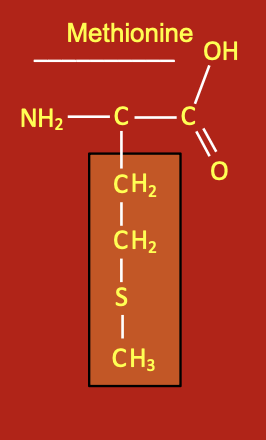
draw threonine
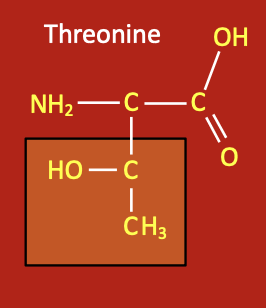
swine limiting amino acids
lysine
threonine
tryptophan
beef cattle limiting amino acids - high forage diet
methionine
arginine
lysine
beef cattle limiting amino acids - high grain diet
arginine
lysine
methionine
poultry limiting amino acids
methinine
lysine
threonine
why are lysine, methionine, and threonine usually the most limiting amino acids in farm animal diets
they are sound in the lowest amounts in plants, have to be supplemented in most livestock diets
what does protein requirement refer to
the requirement of the body for the essential amino acids and especially the limiting amino acids
why do protein requirements differ per species
the microbes are the source of protein for the ruminant (but do not prevent limiting AAs)
monogastrics cannot used microbes as a source of protein
what does protein quality mean
refers to the digestibility of the protein and contains a proportion of essential amino acids relative to the animal’s diet
what can damage protein quality
exposure to high temperatures
protein from animals sources has ________ quality then protein from plant sources
better
meaning some amino acids need to be supplemented, but this is expensive and cows cannot be fed animal protein due to risk of Mad Cow Disease
what protease enzymes are released from the stomach into the stomach
pepsin
what protease enzymes are released from the pancreas into the duodenum
trypsin
chymotrypsin
carboxypeptidase
what protease enzymes are released by the villi and act at the surface of the vili
aminopeptidase
dipeptidase
how does protein digestion happen in the stomach of monogastrics + hindgut fermenters
pepsin begins breaking down the proteins into shorter chains of amino acids
pepsin only works at a low pH so it works in the stomach but not in the duodenum because the pH is too high
how does protein digestion happen in the small intestine of monogastrics + higdgut fermenters
proteins digestion occurs primarily in the duodenum but also in the jejunum and ileum
pancreas releases 3 protease enzymes (trypsin, chymotrypsin, carboxypeptidae) into the duodenum that cut the the long protein chains into short polypeptide chains or dipeptides
villi of the jejunum and ileum release 2 protease enzymes (aminopeptidase, dipeptidase) that act at the surface of the villi and cut the short polypeptide chains or dipeptides into individual amino acids
amino acids then travel to the liver for further processing
how does protein digestion happen in the rumen
no protease enzymes, all protein digestion is performed by microbial digestion
microbes can produce all 20 amino acids and use their own protease enzymes to break down proteins
how does protein digestion happen in the abomasum
pepsin begins breaking down the proteins into shorter chains of amino acids
the protein being used here is coming from the microbes
how are amino acids absorbed into the cell
absorbed directly into the cell from the blood, are used to build new proteins in the cell
define protein turnover
proteins are constantly being built and broken down within the cell
anabolism = building proteins from amino acids
catabolism = breaking down proteins into amino acids to produce energy for the cell
how do proteins provide energy for the cell
after a protein is broken down (catabolism) into amino acids, the amino group is removed leaving two carbon structures, these combine together to form glucose which can then be used to produce ATP
protein→amino acid→2 carbon structures→glucose→ATP
what is urea
as a result of removing nitrogen from amino acids for energy production, the let go nitrogens combine with oxygen and carbon to form a molecule (urea) that is used to remove excess nitrogen from the body
high levels of nitrogen is toxic to animals and humans
urea is filtered from the blood by the kidneys and released in urine
